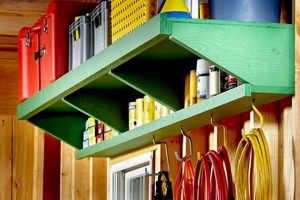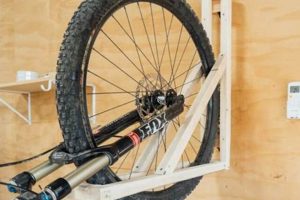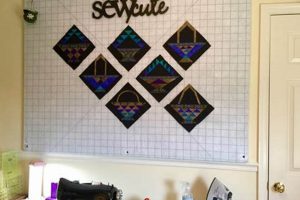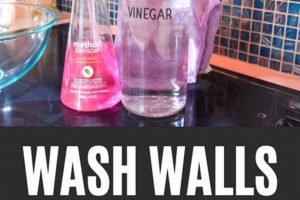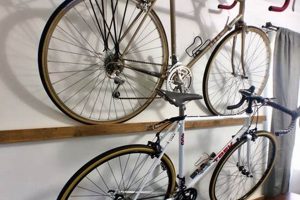The installation of prefabricated surfacing materials in shower enclosures, undertaken by the property owner or resident, constitutes a specific home improvement project. This approach involves selecting panels designed for wet environments and implementing their attachment according to manufacturer specifications, often foregoing the need for professional installation.
Adopting this method can offer advantages that include cost savings compared to professionally installed tile or stone, along with expedited project completion. The materials offer a wide variety of styles replicating natural materials, but frequently at lower maintenance requirements. Historically, this type of improvement has gained traction due to the rise of accessible home improvement resources and specialized product availability.
Subsequent discussions will detail the selection criteria for appropriate materials, the necessary tools and preparation techniques involved, and a step-by-step guide to ensure a successful and watertight enclosure. Furthermore, this discussion will address common challenges encountered during the process and offer troubleshooting strategies.
Essential Guidance for Prefabricated Shower Surfacing Installation
Achieving a professional-grade finish with prefabricated surfacing requires meticulous planning and execution. The following guidance aims to mitigate common errors and optimize the outcome.
Tip 1: Precise Measurement is Paramount. Prior to material acquisition, conduct thorough measurements of the shower enclosure. Account for any irregularities in wall dimensions and factor in panel overlap or edge trimming. Inaccurate measurements can lead to material shortages or unsightly gaps.
Tip 2: Substrate Preparation is Non-Negotiable. Ensure the existing wall surface is clean, dry, and structurally sound. Repair any damaged areas, such as crumbling drywall or loose tiles, before commencing installation. Failure to do so can compromise adhesion and long-term stability.
Tip 3: Adhere Strictly to Manufacturer Instructions. The provided installation guidelines from the panel manufacturer are critical. Variations in material composition and installation methods necessitate adherence to these specific recommendations regarding adhesive type, cutting techniques, and sealing procedures.
Tip 4: Employ Appropriate Cutting Tools. Select cutting tools suitable for the specific panel material. For example, circular saws with fine-tooth blades are often preferred for acrylic panels, while utility knives may suffice for thinner PVC options. Dull blades can result in chipping and uneven edges.
Tip 5: Seal All Seams and Edges Methodically. Apply a high-quality, mildew-resistant sealant along all seams, corners, and edges to prevent water intrusion. Ensure complete coverage and smooth the sealant bead for a professional appearance and enhanced waterproofing.
Tip 6: Maintain Proper Ventilation During Installation. Many adhesives and sealants release volatile organic compounds (VOCs). Ensure adequate ventilation in the work area by opening windows or using a fan to mitigate potential health risks.
Tip 7: Test for Water Tightness Post-Installation. After the sealant has fully cured, conduct a water test to identify any leaks. Address any detected leaks promptly by reapplying sealant or making necessary adjustments.
Adherence to these practices contributes significantly to the longevity and aesthetic appeal of the shower enclosure. Neglecting these steps may lead to premature material failure and water damage.
The subsequent sections will delve into advanced techniques and considerations for customized prefabricated shower surfacing projects.
1. Material Selection
The selection of appropriate surfacing materials is a critical determinant in the successful execution and longevity of a prefabricated shower enclosure project. Material choice directly impacts the enclosure’s resistance to moisture, ease of maintenance, aesthetic qualities, and overall durability. Neglecting careful evaluation of material properties can lead to premature degradation, aesthetic dissatisfaction, and potential structural issues.
- Panel Composition
The core composition of the panel influences its inherent resistance to water absorption and fungal growth. Materials such as acrylic, PVC, and fiberglass-reinforced plastic offer varying degrees of moisture impermeability. Solid surface materials, while more expensive, generally exhibit the highest resistance to water penetration. Selecting a material inherently resistant to moisture is essential to prevent subsurface mold and mildew development.
- Surface Finish and Texture
The surface finish affects cleanability and aesthetic appearance. Smooth, non-porous finishes are easier to clean and less prone to staining. Textures can enhance visual appeal but may also increase the surface area susceptible to soap scum and mineral deposit accumulation. Consider the maintenance implications of textured surfaces when selecting a material.
- Panel Thickness and Dimensional Stability
Panel thickness contributes to structural rigidity and resistance to impact damage. Thicker panels tend to be more dimensionally stable, reducing the likelihood of warping or cracking over time. Evaluate the panel’s ability to withstand typical bathroom humidity and temperature fluctuations without compromising its structural integrity.
- Cost and Availability
Material costs vary significantly depending on composition, finish, and thickness. Consider the overall project budget and the long-term value proposition of each material. Availability can also be a factor, as certain materials may require longer lead times for delivery or may only be available through specialized suppliers. Balancing cost with performance characteristics is crucial for successful project completion.
The facets of panel composition, surface finish, thickness, and cost contribute significantly to the final performance and aesthetic of shower modifications. A homeowner must carefully evaluate these facets to achieve a shower enclosure that meets their functional and aesthetic requirements.
2. Substrate Preparation
Substrate preparation is a foundational element in the successful application of surfacing within a shower enclosure. The condition of the existing wall surface significantly influences the adhesion, stability, and longevity of the newly installed system. Improper substrate preparation can compromise the integrity of the installation, leading to premature failure and potential water damage.
- Cleaning and Degreasing
The removal of contaminants, such as soap scum, mildew, and grease, is essential for proper adhesion. Residue can create a barrier between the panel adhesive and the substrate, weakening the bond. Thorough cleaning with appropriate cleaning agents, followed by a rinsing and drying phase, is necessary to ensure a clean surface. For instance, neglecting to remove silicone residue from a previous repair can prevent proper adhesion of the panels.
- Surface Leveling and Repair
Existing imperfections, such as uneven surfaces, cracks, or holes, must be addressed prior to panel installation. Uneven surfaces can create stress points in the panels, leading to cracking or detachment over time. Repairing damaged areas with patching compounds or shims ensures a uniform and stable base. An example would be filling and sanding holes left from previous tile installations to create a smooth surface.
- Moisture Assessment and Mitigation
Excessive moisture within the substrate can compromise adhesion and promote mold growth behind the panels. Assessing the moisture content of the substrate using a moisture meter is recommended. If elevated moisture levels are detected, appropriate mitigation measures, such as drying the area or applying a moisture barrier, should be implemented. Installing panels over damp drywall, for example, can lead to panel delamination and mold issues.
- Priming and Sealing
Applying a primer or sealer can enhance adhesion and create a moisture barrier. Primers improve the bond between the adhesive and the substrate, while sealers prevent moisture from penetrating the wall. Selecting a primer compatible with both the substrate and the adhesive is crucial. An example would be using a mold-resistant primer on a porous substrate to prevent future mold growth behind the panels.
In conclusion, the effectiveness of these panel installations is inextricably linked to the quality of preparation. Addressing cleaning, leveling, moisture, and priming issues before panels are installed contributes significantly to a durable and aesthetically pleasing finish, and also prevents issues that would shorten the project’s lifespan.
3. Precise Cutting
Accurate dimensional manipulation of surfacing materials represents a critical phase in the execution of prefabricated shower enclosure projects. The integrity of the final installation is directly contingent upon the precision with which panels are cut to conform to the specific dimensions and geometry of the shower space. Deviations from precise measurements can result in gaps, misalignment, and a compromised aesthetic. For example, if a panel intended to cover a 36-inch wall is cut to only 35.5 inches, a noticeable and unacceptable gap will result, requiring additional material and labor to rectify.
Achieving accurate cuts necessitates the utilization of appropriate tools and techniques. The selection of cutting implements, such as circular saws with fine-tooth blades or specialized scoring tools, must be predicated on the material composition of the surfacing panels. Furthermore, meticulous adherence to cutting guidelines, including the use of straight edges and precise measurement tools, is paramount. Practical application includes marking a cut line with a precise measuring tape and a level, and then using a circular saw with a blade designed for plastics to make a clean, chip-free cut. Failure to select the correct tools or cutting methods can lead to chipped edges, uneven lines, and material wastage.
In summary, dimensional accuracy constitutes a non-negotiable element in a successful prefabricated shower enclosure project. The challenges associated with imprecise cutting, including aesthetic deficiencies and potential water intrusion points, underscore the importance of meticulous attention to detail. The utilization of appropriate tools, combined with adherence to established cutting protocols, contributes significantly to the longevity, functionality, and aesthetic appeal of the finished shower enclosure. Such precision is essential for avoiding costly corrections and ensuring a professional-grade outcome.
4. Watertight Sealing
Within the scope of prefabricated shower surfacing projects, the establishment of a hermetic barrier against water intrusion is paramount. This aspect directly influences the longevity of the installation, prevents structural damage to surrounding building components, and mitigates the risk of microbial growth.
- Selection of Appropriate Sealants
The choice of sealant materials is critical to achieving a watertight seal. Sealants specifically formulated for wet environments, such as those containing mildew inhibitors, are essential. Silicone-based sealants or hybrid polymer sealants are commonly employed due to their flexibility, adhesion properties, and resistance to water degradation. Selecting a sealant incompatible with the panel material can compromise the seal’s integrity, leading to leaks and potential substrate damage. For example, using a non-silicone sealant with certain acrylic panels may result in poor adhesion and subsequent water penetration.
- Proper Application Techniques
The manner in which sealant is applied significantly impacts its effectiveness. Surfaces must be clean, dry, and free of contaminants prior to sealant application. Applying a consistent bead of sealant along all seams and joints is crucial, ensuring complete coverage without gaps or voids. Tooling the sealant to create a smooth, concave profile enhances its ability to shed water and reduces the likelihood of debris accumulation. Neglecting proper surface preparation or applying an insufficient amount of sealant can compromise the watertight barrier, allowing water to seep behind the panels.
- Addressing Critical Areas
Certain areas within the shower enclosure are particularly vulnerable to water intrusion and require meticulous sealing. These include corners, seams between panels and the shower base or tub, and penetrations for plumbing fixtures. Reinforcing these areas with multiple layers of sealant or utilizing specialized corner seals can provide added protection. Failing to adequately seal these critical areas can result in localized leaks and accelerated deterioration of the surrounding structure. An example would be neglecting to properly seal the joint between the panels and the shower base, which can lead to water damage in the subfloor.
- Inspection and Maintenance
Regular inspection of sealant lines is essential for identifying signs of degradation, such as cracking, shrinking, or discoloration. Promptly addressing any identified issues by re-applying sealant or making necessary repairs can prevent minor problems from escalating into significant water damage. Periodic cleaning of sealant lines with mild detergents can also help to maintain their integrity and prevent the accumulation of mildew. Ignoring signs of sealant failure can lead to extensive water damage, necessitating costly repairs and potentially compromising the structural integrity of the bathroom.
In conclusion, the effective implementation of watertight sealing practices is fundamental to the overall success of shower enclosures. Employing the appropriate sealant materials, adhering to proper application techniques, diligently addressing critical areas, and conducting regular inspections are all integral components of maintaining a durable, water-resistant shower environment. Neglecting any of these facets increases the risk of water damage, microbial growth, and premature deterioration of the entire shower enclosure system.
5. Proper Installation
The successful execution of surfacing projects undertaken without professional assistance hinges critically on adhering to prescribed installation protocols. Incorrect installation can negate the advantages of utilizing prefabricated components, resulting in compromised structural integrity, aesthetic deficiencies, and increased susceptibility to water damage. Proper installation, therefore, serves as the linchpin for realizing the benefits inherent in a “shower wall panels diy” approach.
Consider the sequence of panel placement as an illustration. Manufacturers often specify a particular order to ensure proper overlap and interlocking of panels. Deviating from this sequence can create misalignments, leading to gaps and potential leak points. Another example lies in the correct use of fasteners or adhesives. Using an insufficient quantity or the incorrect type can lead to panel detachment over time, particularly in areas subject to high moisture and temperature fluctuations. The application of shims to correct for uneven wall surfaces also constitutes a critical aspect of installation. Neglecting this step can result in bowed or warped panels, diminishing the aesthetic appeal and compromising the watertight seal.
In summary, the efficacy of the do-it-yourself approach to shower enclosure surfacing is directly proportional to the rigor with which proper installation techniques are applied. Challenges may arise from unforeseen structural irregularities or a lack of experience. However, meticulous planning, diligent adherence to manufacturer guidelines, and a commitment to precision during installation are essential for achieving a durable, aesthetically pleasing, and water-resistant enclosure. Ultimately, proper installation transforms a collection of materials into a functional and valuable bathroom enhancement.
Frequently Asked Questions
The following section addresses common inquiries regarding the installation of prefabricated surfacing materials in shower enclosures. These questions aim to clarify technical aspects and provide guidance for successful project completion.
Question 1: What specific types of surfacing are most suitable for shower enclosure applications?
Materials specifically engineered for wet environments, such as acrylic, PVC, fiberglass-reinforced plastic (FRP), and solid surface composites, are recommended. These materials exhibit inherent resistance to moisture penetration, preventing the development of mold and mildew. The selection criteria should also consider the material’s long-term durability and resistance to impact.
Question 2: Is professional experience mandatory for achieving a satisfactory outcome?
While prior experience in home improvement projects is beneficial, it is not strictly necessary. The success of such projects relies heavily on meticulous planning, accurate execution of measurements, and adherence to the manufacturer’s installation guidelines. Comprehensive preparation and careful attention to detail are paramount.
Question 3: What measures must be taken to ensure a watertight seal within the shower enclosure?
The application of high-quality, mildew-resistant sealant along all seams, corners, and penetrations is essential. Proper surface preparation, including cleaning and drying, is crucial for optimal sealant adhesion. Regular inspection of sealant lines and prompt remediation of any identified cracks or degradation are necessary to maintain the watertight integrity of the enclosure.
Question 4: What tools are typically required for the installation process?
Essential tools include a measuring tape, level, straight edge, circular saw with a fine-tooth blade (or suitable cutting tool for the specific material), utility knife, caulk gun, and safety glasses. The specific tool requirements may vary depending on the chosen panel material and the complexity of the installation.
Question 5: How can potential challenges, such as uneven wall surfaces, be effectively addressed?
Uneven wall surfaces can be addressed through the application of shims or leveling compounds prior to installation. Careful measurement of the wall surface is necessary to identify areas requiring correction. The use of shims ensures that the panels are installed on a flat and stable plane, preventing stress points and potential cracking.
Question 6: What post-installation maintenance procedures are recommended to prolong the lifespan of the shower enclosure?
Regular cleaning with non-abrasive cleaners is recommended to prevent the accumulation of soap scum and mineral deposits. Inspection of sealant lines should be conducted periodically to identify and address any signs of degradation. Promptly repairing any leaks or damage can prevent more extensive problems from developing.
Adherence to these guidelines and a commitment to diligent execution will contribute significantly to a successful installation and the longevity of the shower enclosure.
The next section will explore advanced techniques and customization options for enhanced aesthetic appeal.
Shower Wall Panels DIY
This discussion has explored the multifaceted nature of shower wall panels DIY projects. From material selection and substrate preparation to precise cutting and watertight sealing, each element contributes significantly to the final outcome. The emphasis on proper installation techniques underscores the importance of meticulous planning and adherence to manufacturer guidelines. Successful implementation of these principles leads to a durable, aesthetically pleasing, and water-resistant shower enclosure.
The information presented herein serves as a foundation for informed decision-making. While challenges may arise, a commitment to quality and precision will yield lasting results. As materials and techniques evolve, continued vigilance and a dedication to best practices will remain essential for achieving optimal outcomes in the realm of shower enclosure modifications.



